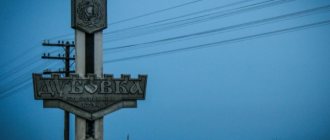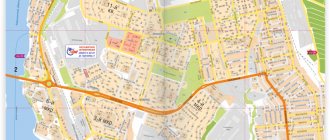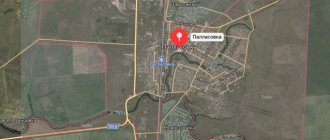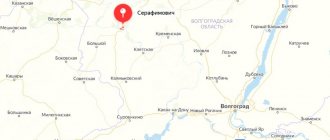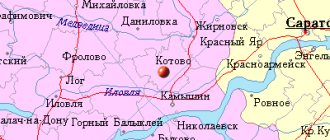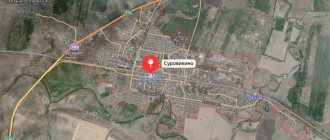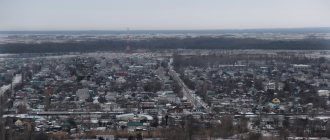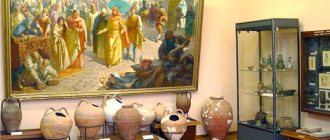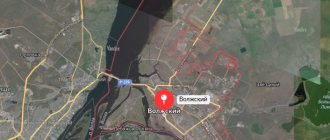Location
The location of the Frolovsky district is the north-west of the region, the bank of the river. Archeda The distance between Volgograd and Frolovo is 148 km. This territorial unit occupies 3,300 thousand sq. km. The terrain is calm; thanks to the numerous beams, the surface is somewhat undulating. Several rivers flow here: Ilovlya, Archeda, Don and Lychak.
Highways pass through the territory: automobile – Caspian M6 and railway (Archeda station). The city of Frolovo occupies 58.36 sq. km. The city is built up, for the most part, by the private sector; its central part is characterized by high-rise buildings.
On the territory of the urban district of Frolovo, deposits of gas, oil, crushed stone and construction sand have been explored.
Frolovo on the map of Russia: geography, nature and climate
The climate of the area where the city is located is temperate continental and arid. It has an unstable moisture regime.
Strong winds blow in winter and summer. Summer in Frolovo is hot and dry. The maximum temperature reaches +45°C. Winter is accompanied by severe frosts down to -40°C.
Precipitation is only 459mm. in year.
A characteristic feature of the development of Frolov is the predominance of the private sector over multi-storey buildings.
The surrounding area of the city is rich in natural resources:
- oil;
- gas;
- limestone.
The soils belong to the category of chestnut soils with sandy loam admixture.
Story
The history of the city of Frolovo began with X. Lyzhinsky - it was under this name that the settlement that later became x was first mentioned in 1859. Frolovsky. At that time, the population of the settlement was 236 people and there were 22 households. The moment of the founding of the Cossack farm, from which the city of Frolovo was later formed, is not precisely indicated anywhere.
The description of the region on the Don from 1791 contains an indication that livestock breeding and farming were carried out on the Archedin banks, and mills and settlements were built. The Cossack farm was located in the depths of the Don steppes, and life there flowed slowly, but everything began to change in the second half of the 19th century.
In 1870, during the construction of the Gryazi-Tsaritsyn railway line, a station called “Archeda” arose here, near the settlement. At the end of the 19th century, the name Frolovo was already found in some publications. After this, the farm began to grow. In 1888, the Church of the Nativity of the Virgin Mary was erected on it, at which the parish school began operating. In 1893 there were two such schools. And at the beginning of the 20th century, a railway school was opened - the children of railway workers studied here. Since 1910, a higher primary school has been operating.
In 1914, there were already 3,500 residents in Frolovo, the number of households increased to 800. The largest number of local residents were Cossacks - about 2,000 people. There were also peasants living here on temporary or permanent basis. About a hundred nobles, members of the clergy and townsfolk also lived in the settlement. 279 people served at Archeda station.
During the Civil War x. Frolov changed hands several times from one opposing side to the other. In 1923, the center of the Kremen volost was located in Frolovo. In 1926, the number of residents increased to 9842. In the summer of 1928, the Frolovsky district was formed, after which the farm acquired the status of a regional center. And in 1936, a decree was issued to transform the Frolovo farm into a city, leaving the usual name.
In 1925, a rather significant event took place for Frolovo - a large group of Czechoslovaks came here, some of them opened workshops: a mechanical workshop (including a foundry), a shoe shop, and a leather workshop. This is how an emigrant artel from Czechoslovakia was formed. In 1932, a small plant for the production of rolled metal was opened.
In pre-revolutionary times, there were only a few medical workers on the farm, and in the 20-30s. A couple of hospitals were already operating successfully in Frolovo – central and railway. Before the outbreak of World War II, a medical school began operating. The first issue of the local newspaper was published in 1930, and in 1938 its name changed. This publication is the oldest of the local ones, it is still published to this day, only over the course of 40 years it has once again acquired a new name, and is now called “Forward”.
During the war with the Nazi invaders, Archeda was a significant object from a tactical point of view - trains with soldiers and equipment passed through here to the besieged city. From mid-1942 to early 1943, German bombers carried out 62 raids on Frolovo, dropping about 1,300 bombs, killing more than 600 civilians and wounding more than 400 people. The bombing destroyed 737 residential buildings, a train station, a post office and a school.
In March 1943, the local railway junction received the first of the trains with Stalingrad orphans. By March 1944, Frolov residents accepted 158 children left without parents into their families. In 1943, nearby, in the local forestry enterprise, an orphanage was formed for the children of soldiers who died at the front. Orphans were brought here not only from Stalingrad, but also from other Russian cities.
In March 1943, the local railway junction received the first of the trains with Stalingrad orphans. By March 1944, Frolov residents accepted 158 children left without parents into their families. In 1943, nearby, in the local forestry enterprise, an orphanage was formed for the children of soldiers who died at the front. Orphans were brought here not only from Stalingrad, but also from other Russian cities.
After the war, mineral deposits were developed. In 1946, the first gas deposits were discovered. Two years later, oil was discovered, and in 1949 the Archedinsky oil field was organized. In 1953, Stalingrad began to receive gas from Archeda via the newly opened gas pipeline. In 1954, a maternity hospital with 60 beds was built near the district hospital.
In 1957, four buses were launched in the city at once. By the way, now there is one more of them. From 1960 to 1961 two cinemas were opened.
In 1964, the construction of a steel plant began, which is still in operation. In 1967, the Palace of Culture, designed for 800 seats, was founded; now it is a cultural center with city status, where various creative groups conduct classes. At the same time, the Don Frolovo water supply was built; local water is recognized as one of the purest and most delicious in the entire region.
State Pedagogical Technical University No. 31 opened in 1973. In 1984, a local history museum opened its doors, which still conducts excursions for local schoolchildren. In 1994, it began broadcasting on television, which is now called “ArTV”.
In 2009, the consecration of the Epiphany Cathedral, which is part of the Bogoroditsko-Nativity parish, took place. The temple located near the station became the city's spiritual center.
Now the city of Frolovo is being modernized; spiritual and cultural traditions are carefully preserved and passed on to new generations.
Routes on the map of Frolovo. Transport infrastructure
The railway tracks passing through the city belong to the Volga Railway. The Archeda station (18 Narodnaya St., in the city center) receives a flow of passenger trains heading to St. Petersburg, Moscow, and Volgograd.
There is also a freight railway station “Zavodskaya” in the city, located on the Archeda branch.
Automobile transport
M6 (Caspian) passing near the city .
Several local highways pass through the village of Frolovo:
- 18A4 Frolovo – Kamyshin;
- 18N133 Frolovo – Padok
- 18K8 Frolovo – Danilovka.
You can move around the city by public transport. Its list includes:
- buses;
- minibuses.
Intercity passenger transportation is entrusted to the Frolovskoye PATP. All buses of this organization begin their route from the Archeda railway station. The exception is buses serving route No. 101, which starts from the Frolovsky Market municipal unitary enterprise and connects the city with the village of Zheleznodorozhny.
Intercity transportation of passengers from Frolov is carried out to the following settlements:
- Nizhnye Lipki;
- Fall;
- Kremenskaya;
- Volgograd;
- Malodel;
- Dumpling Post;
- Dudachny;
- Chernushka;
- Druzhilin;
- Serafimovich;
- Danilovka;
- Way.
Job
There are surprisingly many job offers in the Frolovsky district, compared to other similar territories. Moreover, the vacancies are very diverse: employees are required in the trade and transport sectors, banks and beauty salons, etc.
For example, full-time workers are required for the production of paving slabs in the city of Frolovo; work experience is not required. Salary – 25,000 rubles per month (Advertisement No. 2127911553).
Economy and industry Frolovo
The city belongs to the large industrial centers of the region. There are 44 industrial enterprises operating on its territory. The largest of them include:
- OJSC "FEST" (Frolovsky steel plant);
- LLC TsBPO "Volganeftemash";
- Archedin route distance;
- Carriage repair depot "Archeda";
- Archedan Industrial Group LLC;
- "Volgogradavtodor" branch of the OGUP "Volgograd Quarry Management".
Not far from Frolovo, industrial oil and gas production takes place. There is a workshop at the Volgogradneftegaz Chamber of Commerce and Industry, which belongs to RITEK OJSC.
Pre-trial detention center 3
The pre-trial detention center or Pre-trial Detention Center 3 is located in the city of Frolovo, on the outskirts. This institution was founded in 2004. And in 2011, a new secure building with 420 places was put into operation.
In September 2022, with the permission of the Chief Sanitary Doctor of Medical Unit No. 34, long-term visits were resumed, but fairly strict requirements are applied to obtain them. The transfer of food and belongings to prisoners and the special FSIN-Money system, with which you can transfer money to a prisoner in pre-trial detention center No. 3, have also been organized.
Main streets of Frolovo
On the map of Frolovo with streets you can find any desired street in the city. But, as in every city, there are main streets, which include:
- Spartakovskaya street . Passes through most of the city along the left side. There are 244 houses on it. Starts from Frunze Street. Very close to the street is the City Administration building and its Central Square;
- Dzerzhinsky Street . Crosses almost the entire city. It starts from Spartakovskaya Street and stretches to Proletarskaya Street. There are 121 houses on it;
- Stroiteley street. It crosses almost the entire city along the right. Starts from Frunze Street. Not far from its beginning is the 2nd cemetery. There are 284 houses on it;
- 40 Let Oktyabrya Street , like Stroiteley and Spartakovskaya streets, crosses the entire city lengthwise, but in the center. It is not only the main street of the city, but also the longest in length. There are 427 houses on it.
The location of all shops, schools, hospitals and other public buildings should be found on the map of Frolovo with houses.
IK 25
In 1966, a men's correctional labor institution with a high security regime was created. It is located in the northern part of Frolovo. His boss was a WWII veteran with the rank of colonel of the internal service, S.V. Tyunyaev. In 1967, the first 600 convicts were settled in IK 25. After 4 months, the number of prisoners increased to 1000. They were employed in the construction of a cutting shop and a steel production plant.
In 1970, the correctional facility was already completely ready, and in 1971, the construction of a steel mill was completed, in which ordinary hired workers began to work. And in the heat-cutting shop, which has a special fence, prisoners worked. The convoy escorted prisoners from the colony to work and back 6 times during the day. Then the road to the steel plant began to be called Tyunyaev Avenue.
In 1973, ITK No. 14 was repurposed into LTP No. 2. At that time, there was a sharp leap in the development of our own production and the formation of subsidiary farming. The products were not only supplied throughout Russia, but were also exported.
In June 1994, LTP No. 2 was reorganized into strict regime penal colony No. 25. The institution is designed for 903 convicts. Now FKU IK No. 25 produces and sells wood building materials, lumber and clothing products, carpentry and metal products, meat, pasta and bread, and provides household services to local residents.
Houses for maternal capital in the Volgograd region
Sights of the city of Frolovo
While in the city, you can walk through its memorable places and see the following attractions:
- Church yard , consisting of 2 temples; the Church of the Great Martyr Panteleimon and the Epiphany Cathedral;
- Komsomolsky Park . In it you can see the sculpture “Angel of Peace”, the Chapel of Peter and Fevronia, “Alley of Brides”, “Bench of Lovers”, etc.;
- Central city square;
- memory lane;
- Monument to the Afghans;
- Monument to well No. 4 of the Archedinskoye field.
